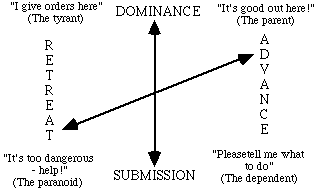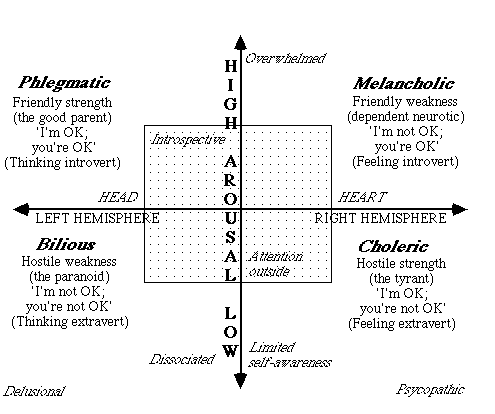Imprint Types
by Peter Shepherd
A wide range of behavioural tendencies result from the imprinting of the basic bio-survival dynamic of "advance - retreat" corresponding to friendliness (which may be introverted if the advance is resisted) and hostility (which may be extraverted if the retreat is resisted).
This works in conjunction with the emotional-territorial dynamic of "dominance - submission" corresponding to strength and weakness.

These dynamics (or behavioral programs) are originally imprinted in the early years of life, according to the way one experiences one's upbringing. Together they create a two-dimensional social space in which the panorama of human personality-types can be manifested. These are illustrated in following catalogue of Human Responses:
The trait of Dominance (or mastery over others) requires strength, and this may be utilised in either a hostile (towards or against) or friendly (interactive) manner:
A. DOMINANCE: HOSTILE STRENGTH
This is a "Choleric" personality, in the extreme a tyrant. The basis is "I'm OK, you're not OK", so there is a strength of sorts "I'm OK" and a retreat from the other "You're not OK" and an emotionally unstable extraversion in resistance to his withdrawal from the other. Towards the unstable end of the Choleric personality, he is touchy, restless, agressive, excitable, changeable; at the more extraverted end, he is egotistical, impulsive, optimistic, active. There are two strategies to dominate in a hostile manner:COMPETITIVE-NARCISSISTIC
(This list, like others below, reads down from neurotic behaviour to relatively unaffected behaviour)
MANAGERIAL-AUTOCRATIC
- Cold & unfeeling; Egotistical & conceited
- Shrewd & calculating; Snobbish, boastful
- Thinks only of himself; Proud & self-satisfied
- Indifferent to others; Assertive, self-confident, independent
- Likes to compete
- Can take care of self; Self-respecting
- Dictatorial; Expects everyone to admire him
- Manages others; Acts important
- Bossy, dominating; Always giving advice
- Likes responsibility; Makes good impression
- Good leader, forceful; Liked & respected
- Able to give orders; Well thought of
B. DOMINANCE: FRIENDLY STRENGTH
This is the "Phlegmatic" personality, the parent figure. The basis is "I'm OK, you're OK too", so there is the strength of "I'm OK" and an advance towards the other "You're OK" and an emotionally stable introversion in response to the other - though with some resistance to his affinity for the other, hence the introversion. Towards the more stable end of the Phlegmatic personality, he is calm, kind, even tempered, reliable; at the more introverted end, he is controlled, peaceful, thoughtful, careful, passive. The Phlegmatic can develop into the "Sanguine" personality if the resistances towards his natural affinity towards others are overcome.There are two strategies to dominate in a friendly manner:
RESPONSIBLE-HYPERNORMAL
COOPERATIVE-CONVENTIONAL
- Spoils people with kindness; Tries to comfort everyone
- Overprotective; Forgives everything
- Generous to a fault; Over-sympathetic
- Enjoys taking care of others; Gives freely;Tender & soft-hearted
- Big hearted & unselfish; Kind & reassuring; Encourages others
- Helpful; Considerate
- Loves everyone; Agrees with everyone
- Likes everybody; Wants everyone's love
- Friendly all the time; Easily influenced
- Warm & sociable; Eager to get along with others; Always pleasant & agreeable
- Affectionate & understanding
- Friendly; Co-operative
The trait of Submission (or sympathy for others) requires adopting a weak stance, and this too may be utilised in either a hostile or friendly manner:
C. SUBMISSION: HOSTILE WEAKNESS
This is a "Bilious" personality, at the extreme a paranoid. The basis is "I'm not OK, and you're not OK either", so there is a weakness - "I'm not OK" and a retreat from the other - "You're not OK" and an emotionally unstable extraversion in resistance to his withdrawal from the other. Towards the unstable end of the Bilious personality, he is nervous, distrustful, covertly hostile, jealous, angry; at the more extraverted end, he is antagonistic, rebellious, hard hearted and even sadistic. There are two strategies to be submissive but in a hostile manner (that covers up the self-doubt):
REBELLIOUS-DISTRUSTFUL
AGGRESSIVE-SADISTIC
- Distrusts everybody; Rebels against everything
- Slow to forgive; Complaining
- Jealous, stubborn; Bitter, resentful
- Frequently disappointed; Sceptical
- Hard to impress; Often gloomy
- Touchy & easily hurt; Resents being bossed
- Able to doubt others; Can complain if necessary
- Hard hearted; Cruel & unkind
- Often unfriendly, angry; Intolerant of others
- Outspoken; Self-seeking, sarcastic
- Critical of others; Stern but fair
- Irritable; Firm but just
- Straightforward
- Can be frank & honest; Can be strict if necessary
D. SUBMISSION: FRIENDLY WEAKNESS
This is the "Melancholic" personality, the dependant person. The basis is "I'm not OK, but you are OK", so there is the weakness of "I'm not OK" and an advance towards the other: "You're OK". This is an emotionally unstable introversion in response to the other, though with some resistance to the affinity for the other, hence the introversion. Towards the more unstable end of the Melancholic personality, he is moody and anxious; at the more introverted end, he is rigid, sober, pessimistic, reserved, unsociable and quiet. There are two strategies to submit in a friendly manner:DOCILE-DEPENDENT
SELF EFFACING-MASOCHISTIC
- Will believe anyone; Clinging vine
- Lets others make decisions; Hardly ever talks back
- Likes to be taken care of; Dependent; Wants to be led
- Anxious to be approved
- Trusting; Very respectful to authority; Admires & imitates others
- Appreciated; Grateful
- Spineless; Ashamed of self
- Obeys too willingly; Self-punishing
- Passive & unaggressive; Shy, timid
- Weak; Easily embarrassed
- Usually gives in; Lacks self-confidence
- Modest, easily led; Apologetic
- Can be obedient; Able to criticise self
The Sanguine Personality
There is a fifth personality type, one that is not resisting and therefore not stuck in extravert or introvert patterns of behaviour. This is the "Sanguine" personality, the person who knows himself. He (or she of course) is not necessarily playing a Dominating or Submissive game. There is no compulsive movement towards, against or away; instead there is interaction and two-way communication.Like the Phlegmatic, the Sanguine is operating on the basis of "I'm OK, you're OK", so there is the strength of "I'm OK" and an advance towards the other "You're OK". But there is a stable response to the other that is without resistance to affinity, so the Sanguine is extraverted or introspective at will, both emotionally (empathy) and intellectually (willing to see others' points of view). He has qualities of leadership, is carefree, lively, spontaneous, responsive, talkative, cheerful, outgoing and sociable - ie he really is, without underlying dominating or submissive motives.
The following diagram illustrates how the above qualities relate to both overall mental arousal and left-right hemispheric balance:

Further insight into these personality types may be gained from the in-depth Questionnaire, "Know Your Own Mind" which I recommend as a useful action to accompany this Chapter.
The Programs of the Body-Mind
The bio-survival program is intense conditioning, an imprint or circuit built into the brain, installed at critical times of vulnerability, at first by the supporting and nourishing function of the mother (so it is Matrist and "oral"), and further conditioned by subsequent nourishment or threat. It is primarily concerned with sucking, feeding, cuddling, and body-security, giving one the right to exist and to be secure in one's needing: the bio-survival dynamic. It very simply programmes an either/or choice: go forward to the nourishing, the protective - a friendly response; or go back, away from the threatening, the predatory - a hostile response. In later life, the "oral" character, lacking such basic security, a need which was not adequately met, acts like an infant.The emotional-territorial program is imprinted at the "toddling" stage, chiefly by the father (so it is Patrist), when the infant rises up, walks about, asserts itself and begins to struggle for power within the family structure. These are the vulnerable points when imprinting and heavy conditioning occur. This program processes territorial rules, emotional games, pecking order and rituals of domination and submission. It is the basis for "ego" - the recognition of one's status in the pack, between top dog or bottom dog. The right to be independent, to want and to move toward the satisfaction of these wants openly and directly. If insecure in this way, the "egotist" behaves "like a two year old" because ego is the imprint of the toddling and toilet-training (anal) stage.
Note that the tyrant is inclined to paranoid withdrawal; he must govern but he is also afraid. Also that the dependent neurotic is not in retreat at all; he or she advances upon you, demanding fulfilment of emotional "needs" (imprints). These four quadrants have been known since the dawn of self consciousness. For instance in the terminology of the medieval pschology of "humours", these four imprint types were known as:
Bilious (hostile weakness - archetype Bull; element Earth),This system is not meant to be rigid or to imply that there are only four types of humanoid robots. There are all the variations in the above table of Human Responses and there are further programs to take into account (to be explained later), and the individual may have different imprinted responses in different situations. Nevertheless, people will tend to be disposed to the most commonly adopted area. Consider four specific cases:
Choleric (hostile strength - archetype Eagle; element Air),
Phlegmatic (friendly strength - archetype Lion; element Fire),
Melancholic (friendly weakness - archetype Angel; element Water).
Subject #1 is Responsible/Over-conventional (Phlegmatic). He (or she) is friendly, considerate, helpful, solidly successful and wants things to run smoothly for the good of all, whatever the compromises. He spoils people with kindness, forgives anything, agrees with everybody and actually enjoys governing those who cannot govern themselves. The noble Lion. This person may nevertheless act as a robot, i.e. in a programmed manner, if he can never give orders in a strict way, is never ever to doubt others, is never ego-centred, etc. On the other hand if he can move out of this viewpoint in appropriate circumstances (exercising hostility against an attacker or admitting weakness when overwhelmed) then he has a conditioned predilection for "friendly strength" but is not totally robotised by it.
Subject #2 has, after the same twenty years of imprinting and conditioning, landed in the Melancholy quadrant (friendly weakness). He is self-critical, shy, timid, easily led, spineless and always looking for someone to take charge, to make the decisions. The unearthly Angel or in modern parlance, the flower child.
Subject #3 is predominantly in the Bilious (hostile weakness) quadrant. He distrusts everybody, rebels against everything, speaks constantly in sarcasms, complains chronically and is generally bitter, resentful and (to some extent) paranoid, while skilfully avoiding any action that would require taking personal responsibility. The sullen Bull. Subject #4 is Choleric (hostile strength) and is regarded as bossy, cold, unfeeling, dictatorial, self-important, boastful, etc., but still in the judgement of most, "a good leader". He will always try to take over, to be top dog. The imperial Eagle.
Each of these robotic, endlessly repeated reflexes are stimulated or brought into play by the situations around the person, i.e. by the behaviour of other people and circumstances that occur, which restimulate the program and subconsciously, the incidents which originally served to imprint the program.
A truly balanced person - the Sanguine - is able to adjust internally to circumstances as they arise, to move a little bit into each quadrant as the situation requires, but basically maintaining a centred detachment from robotic programs. This is similar to the concept of a Buddhist mandala, an aid to centered meditation, with the centre representing awakening and the outer complexity representing the programs.
Return to Transforming the Mind - Contents.
Continue to the next article, The Semantic Mind.